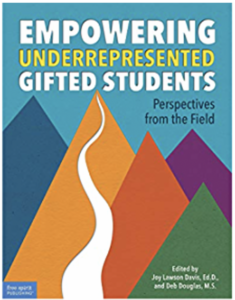Help Underrepresented Gifted Students Succeed
Empowering Underrepresented Gifted Students: Perspectives from the Field
Edited by Joy Lawson Davis, Ed.D. and Deb Douglas, M.S.
(Free Spirit Publishing, 2021 – Learn more)
Reviewed by Erin Corrigan-Smith

Students identified as gifted can require additional support, due to socio-economic or other conditions, and there needs to be more professional development focused on helping teachers to help students reach their fullest potential.

As schools give more emphasis to gifted education, there needs to be more culturally sensitive instruction to help educators work with a more diverse community of gifted students.
Empowering Underrepresented Gifted Students: Perspectives from the Field is a research-based collection of articles and essays from researchers and practitioners with special knowledge of gifted education who offer actual insight from the field. Included are discussions of classroom focused instructional methods that address systemic issues in education, such as the underrepresentation of minority students.
Contributors present real-world experiences
Each chapter is written by a different expert in gifted instruction, and each chapter illustrates a specific issue in educating underrepresented gifted students. For instance, the chapter “Moving Beyond Disabilities: Twice-Exceptional Students and Self-Advocacy” addresses students who are many times overlooked for gifted testing due to their IEPs or 504 educational plans. Students can be both gifted and require an IEP, and more schools and educators should be made aware of this.
Perhaps the best aspect of the text is that it represents the views of actual practitioners. All the chapters are written from real-world experiences, and there is very little “fluff” in the content. The case studies and stories are about real kids in real classrooms with real needs, and there is a lot of care and focus given to identifying and addressing specific needs.
A focus on self-advocacy
An overarching theme of the text is to encourage self-advocacy for gifted students from all backgrounds. This skill is so important to helping underrepresented students assert their needs both in and out of the classroom, which in turn helps educators better serve the student as they learn and grow.
Each chapter is unique in its layout, though they all contain actual stories from the classroom. There are focused snapshots of genuine student interactions and on how educators originally addressed perceived student needs and then how they learned to address actual student needs.
Each chapter is focused on a specific minority, such as “American Indian” or Hispanic learners, so it is easy to navigate the text to find and address specific needs. Though each chapter addresses a specific underrepresented type of student, the over-arching discussion is valuable in any gifted education setting.
Each chapter has information that can be modified and utilized in a variety of classroom settings. Each chapter addresses a need, and these needs often overlap, which underscores how the proliferation of students who are both gifted and underrepresented is changing the landscape of traditional gifted education programs and spotlighting the need to assure that all gifted students realize our promises of fairness, equity and support as they explore their full potential.
Erin Corrigan-Smith is a secondary ELA teacher in a suburb of Atlanta. She has a B.A. and M.A. in English, and her focus of study is children’s literature. She has recently returned to school to earn an Ed.D. in Reading and Literacy. In her downtime, she enjoys going to her family’s cabin in the North Georgia mountains, with her husband and dog, to read, to complete her never-ending piles of homework, and to relax.


































